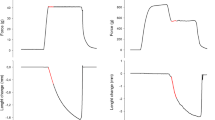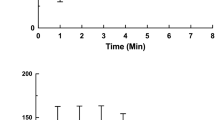Abstract
Previous observations have shown that, in isolated perfused dog gastrocnemii in situ, stimulated to aerobic rhythmic isotonic tetanic contractions (at about 40% of maximal isometric force), only about 20% of the overall metabolic power (proportional to the rate of O2 consumption, V̇O2) was converted into mechanical power (Ẇ). Here we report that, in the same preparation, the maximal velocity during the shortening phase of each tetanus (v, mm s−1) increased with the rate of energy dissipation, as given by the difference between V̇O2 and Ẇ (W kg−1). The relationship between these variables was described by: v=2.85(V̇O2−Ẇ)1.24 (R 2=0.85; n=17). A mathematical analysis of this equation shows that the overall mechanical efficiency (η=ẆV̇O2 −1) decreased with increasing v (at constant V̇O2), whereas it increased with increasing V̇O2 (at constant v). The net effect of this state of affairs was that the decrease of η over the entire range of work intensities was relatively minor (from 0.22 to 0.15), in spite of a large increase of v, (from 40 to 120 mm s−1), thanks to the concomitant increase of V̇O2 (from 10 to 25 W kg−1). So, under these experimental conditions, the energetics of work performance seems to be governed by two conflicting needs. The need for a sufficiently high shortening speed (and hence power output), itself requiring a sufficiently large energy dissipation rate, which, however, brings about a fall in η. This is counteracted by the increased V̇O2, which in turn leads to an increased efficiency at the expense of a fall in shortening speed.



Similar content being viewed by others
References
Brace RA (1977) Fitting straight lines to experimental data. Am J Physiol 233:R94–R99
Canfield P, Maréchal G (1973) Equilibrium of nucleotides in frog sartorius muscle during an isometric tetanus at 20°C. J Physiol (Lond) 232:453–466
Chaplain RA, Frommelt B (1972) The energetics of muscular contraction. I. Total energy output and phosphorylcreatine splitting in isovelocity and isotonic tetani of frog sartorius. Pflugers Arch 334:167–180
Curtin NA, Gilbert G, Kretzschmar KM, Wilkie DR (1974) The effects of performance of work on total energy output and metabolism during muscular contraction. J Physiol (Lond) 238:455–472
Kushmerick MJ, Davies RE (1969) The chemical energetics of muscle contraction. II. The chemistry and power of maximally working sartorius muscles. Proc R Soc Lond B 174:315–353
Margaria R, di Prampero PE, Aghemo P, Derevenco P, Mariani M (1971) Effect of a steady state exercise on maximal anaerobic power in man. J Appl Physiol 30:885–889
Piiper J, di Prampero PE, Cerretelli P (1968) Oxygen debt and high energy phosphates in gastrocnemius muscle of the dog. Am J Physiol 215:523–531
Prampero PE di (1981) Energetics of muscular exercise. Rev Physiol Biochem Pharmacol 89:143–222
Prampero PE di (1989) Shortening speed and muscular efficiency: from frog muscle to exercising man. In Wieser W, Gnaiger E (eds) Energy transformations in cells and organisms. Thieme, Stuttgart, pp 46–53
Prampero PE di, Margaria R (1968) Relationship between O2 consumption, high energy phosphates and the kinetics of the O2 debt in exercise. Pflugers Arch 304:11–19
Prampero PE di, Cerretelli P, Piiper J (1969) Energy cost of isotonic tetanic contractions of varied force and duration in mammalian skeletal muscle. Pflugers Arch 305:279–291
Prampero PE di, Meyer M, Cerretelli P, Piiper J (1981) Energy sources and mechanical efficiency of anaerobic work in dog gastrocnemius. Pflugers Arch 389:257–262
Prampero PE di, Boutellier U, Marguerat A (1988) Efficiency of work performance and contraction velocity in isotonic tetani of frog sartorius. Pflugers Arch 412:455–461
Wilkie DR (1960) Thermodynamics and the interpretation of biological heat measurements. Prog Biophys Biophys Chem 10:260–298
Author information
Authors and Affiliations
Corresponding author
Additional information
This article was published in “Human Muscular Function during Dynamic Exercise”, Marconnet P, Saltin B, Komi P, Poortmans J (eds) Med Sport Sci 41 (series editors: M. Hebbelink, R.J. Shephard) pp. 1–9, Karger, Basel, 1996. It is reproduced with minor editorial modifications. Permission from Karger is gratefully acknowledged.
Rights and permissions
About this article
Cite this article
di Prampero, P.E., Piiper, J. Effects of shortening velocity and of oxygen consumption on efficiency of contraction in dog gastrocnemius. Eur J Appl Physiol 90, 270–274 (2003). https://doi.org/10.1007/s00421-003-0947-7
Published:
Issue Date:
DOI: https://doi.org/10.1007/s00421-003-0947-7




